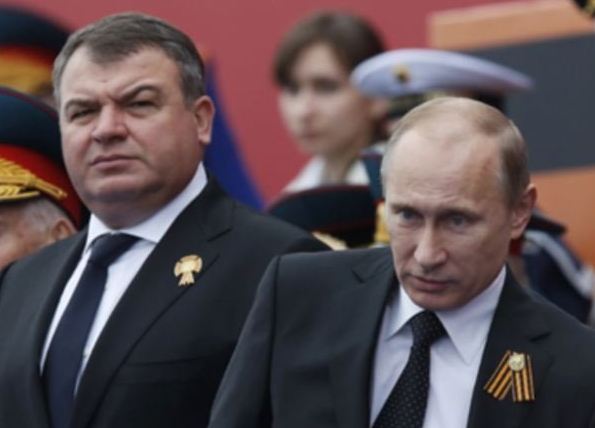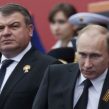
Russia’s ‘Military Reform’: Flowers, Weeds and AWOL Gardeners
Publication: Eurasia Daily Monitor Volume: 9 Issue: 159
By:

Four years after launching the reform of Russia’s conventional Armed Forces, which many wrongly equate with “military reform,” a bleak picture is emerging from within the military concerning its progress to date. The Russian Ministry of Finance recently published figures related to defense and security spending for 2012 to 2015, which gives a semblance of steady state support for rearmament. But despite the presentation of the flowering of the reform “strategy,” more evidence is appearing about its numerous weeds, dying flowers and complete lack of overall planning. What Russian officers have come to perceive as “Serdyukovshchina” (a hybrid of the defense minister’s name and the practice of brutal hazing in the military known as “dedovshchina”) is most striking in the seemingly endless series of reform experiments and setbacks that expose no real conceptual approach as its basis.
The figures published by the finance ministry indicate that expenditures to support national defense, security and law enforcement have been significantly increased for the period 2013–2015. These figures are increased from 3.709 trillion rubles ($115.3 billion) each for national defense, security and law enforcement in 2012, to 4.3569 trillion rubles ($135.5 billion), 4.6551 trillion rubles ($144.7 billion), and 4.9388 trillion rubles ($153.6 billion) in 2013–2015, respectively. Reportedly, the emphasis in the spending plans are as follows: developing the nuclear forces, aerospace defense assets, communications systems, command and control and reconnaissance systems, electronic warfare, unmanned aerial vehicles, robotic strike complexes, modern transport aviation, high-precision weapons and the means to counteract these, individual protection systems for military personnel, and developing the Navy in the Arctic and the Russian Far East (www1.minfin.ru, August 2).
To argue that such high ambition will test the domestic defense industry is evidently an understatement, but the level of oversight involved in such defense companies may increase. Russian journalist Viktor Litovkin reviewed possible approaches that might be pursued by President Vladimir Putin in an effort to boost the defense industry. One such idea is to re-establish the system of “military acceptance,” which was abolished and consequently the military product standardization process arguably lost quality assurance mechanisms. First Deputy Defense Minister Aleksandr Sukhorukhov stated that in 2010 “1,764 deficiency reports” were filed by the defense ministry with the defense industry for the low quality of armaments sent to the army and navy, or a 20 percent increase year-on-year. In the first half of 2011, an additional increase of 10 percent in such complaints was recorded, and since then the defense ministry has gone quiet on the issue (Nezavisimoye Voyennoye Obozreniye, July 4).
A notorious example of the chronic condition of the Russian defense industry relates to the RSM-56 Bulava, which led to a “failure to launch” saga that proved to be embarrassing for the political-military leadership. Only after video cameras were installed over each workplace to monitor every element in the assembly process, did the whole business of production take a turn for the better. The message seems clear: more oversight is required. Litovkin noted that using a “military acceptance” office would almost imply a return to a socialist-style production system. “Today times have significantly changed, and it has become understandable that a man in uniform must not stand over the spirit of each master, if he actually is a master, and track strictly, how he fastened this or that gasket, how the pipeline pressure is, and how the screws are locked. […] There are no similar monitors in any highly developed country with highly developed precision manufacturing. There, the quality of production depends on the highly developed, automated and computerized manufacturing base and high-class specialists who monitor themselves,” he observed. The system of military production has become dysfunctional, and no state-led effort will likely yield an easy fix (Nezavisimoye Voyennoye Obozreniye, July 4).
According to Litovkin, Defense Minister Anatoliy Serdyukov is inclined to recreate an office of “military acceptance” as a desperate measure to improve standards. The underlying problem, however, is that there are no longer any military educational establishments to train military acceptance specialists; these were closed by Serdyukov. Indeed, many of these specialists were not absorbed into alternative educational establishments. Consequently, the teachers, cadets and students’ continuity has also been lost. Litovkin concludes: “In a word, it is easier to tear down than to build, and the heart will not ache. And how much we will pay out for ill-conceived and ill-prepared ‘reforms,’ only God knows” (Nezavisimoye Voyennoye Obozreniye, July 4).
Kommersant’s defense correspondent, Viktor Baranets, links the problems of reform and modernization to the poorly planned nature of the entire process. The Army reform conducted in the 19th century by Dmitry Milyutin was the most successful in Russian history. However, Baranets uses the reference to Milyutin to test the Serdyukov approach. The key difference in how Milyutin approached reform was in presenting his ideas to the head of state, who told him “Now go and discuss all your ideas thoroughly with the Army’s officers. If they approve, I will sign the edict,” and Milyutin replied: “I have spent almost a year discussing every point in my plan with the officers a hundred times. All their suggestions and criticisms have been taken into account.” Serdyukov at no time has even made an effort to explain his “reforms” to the Russian officer corps, let alone seek to build such reform consensus. Baranets explains that Milyutin’s reform depended upon the Army command having a solid understanding of the purpose and changes implemented, and as a result they could support these changes (Kommersant, July 19).
On the contrary, according to Baranets, four years after commencing the reform of the Armed Forces, limited to the defense ministry forces, Russian officers have little or no idea as to what it is all about. Senior officers see the reform lurch from one extreme to another, and more pointedly officers only learn about these initiatives through the defense ministry website or in the military press—and never from the minister. The list of reversals is endless: setting the final size of the officer corps at 150,000 or 220,000, announcing the need and planning of a new cadre of non-commissioned officers only to realize there was no underlying concept, downsizing the educational officer numbers then figuring out more were required. Cynically, Baranets listed the achievements of the reform process, including acquiring a “colonial” naval platform (Mistral) or taking Borey class submarines into service without missiles (Bulava). Baranets asks where this approach might lead (Kommersant, July 19).
Unlike some Western analyses of the reform, Russian military specialists see mostly the weeds growing in abundance in the reform garden, but Baranets questions and finds wanting the capabilities of the reform gardener. Serdyukov’s defenders seem mesmerized by the changes he introduced, almost equating “change” with “reform,” as though the two are synonymous. Yet, Baranets declares the absence of a real reform gardener. As the Russian officer corps know, Serdyukov is no Milyutin.




